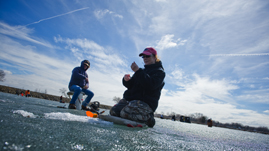Teachers' Domain - Digital Media for the Classroom and Professional Development
User: Preview

Source: Produced by the Wisconsin Educational Communications Board.
Climate change is affecting the duration of ice cover on Lake Monona in Madison, WI. In this multimedia video produced by the Wisconsin Educational Communications Board, learn about the relationship between ice fishing and decreasing ice cover through the eyes of two local ice fishers.
Throughout Wisconsin during the cold winter months, frozen lakes are dotted with fishermen and ice houses. Ice fishing in Wisconsin dates back well before the arrival of European settlers to when American Indians chopped holes in the ice in order to spear fish to supplement their winter diets.
But as any ice fisherman knows, the season with ice thick enough to walk on is short, and can end suddenly and unpredictably with the onset of warm weather. With climate change models predicting warmer temperatures, we can expect to see a trend towards fewer days of ice-covered lakes as each year passes. In fact, with the aid of a remarkable dataset from Madison’s lakes, scientists infer that a change in ice persistence has already taken place.
University of Wisconsin-Madison researchers have collected data beginning in 1855 recording the dates on which lakes Monona and Mendota have frozen (“ice in”) and thawed (“ice out”). While the dates vary greatly from year to year, the overall trend for shorter ice seasons is clear. The record for Lake Mendota shows that the five longest ice-cover seasons on record all occurred between 1855 (the beginning of the dataset) and 1880. Four of the five shortest ice-cover seasons have occurred since 1980. The average number of days the lake stays frozen has dropped from 122 for the first 20 years of the record to just 91.5 for the last 20.
An important property of water is its high specific heat, or the amount of energy a substance absorbs for every degree that its temperature rises. For this reason, water temperature changes more slowly than air temperature. Records of the freezing and thawing of lakes thus serve to average out the day-to-day variations of air temperatures and provide a good picture of broader trends. This makes them a powerful tool for teasing out small climatic changes from a noisy record. Taken as a whole, the data from lakes Mendota and Monona suggest that the winters around Madison have, on average, gotten warmer over the past 150 years.
But other local factors, such as changes in land use, might impact ice cover at any one spot. For this reason, scientists are careful not to put too much weight on a single piece of evidence, but instead look for patterns in multiple places. Thus, University of Wisconsin-Madison lakes researcher John Magnuson scoured the globe for other ice records. He was able to find 39 records from the Northern Hemisphere with 150 years of data or more. What they showed was striking: In all but one of the records, the ice-in date has become later, and the ice-out date earlier, with the average ice cover season becoming almost 18 days shorter.
These data support what the climate models predict—that the earth is warming. Looking to the future, average winter temperatures in Wisconsin are expected to rise some 7–9°F (4–5°C) by 2055, a change which would have dramatic impacts on ice cover on its lakes. The extent of these changes is uncertain, but one thing is clear: both scientists and ice fishermen will be watching with interest.
Here are suggested ways to engage students with this video and with activities related to this topic.
 Loading Standards
Loading Standards